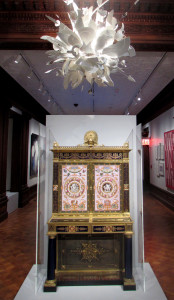Renovated Cooper-Hewitt Impresses NYC VIP Crowd
EVENTS > NYC ANTIQUES WEEKEND
DECORATIVE ARTS TRUST ANTIQUES WEEKEND 2015
In New York City, where the Met, MoMA, Guggenheim, and Whitney garner the lion’s share of museum-related press, the intense buzz about Cooper-Hewitt’s reopening following a lengthy and comprehensive renovation was notable. An investment of $91 million suggests the depth and extent of the three-year project, during which time the museum was shuttered, and the great anticipation for an opportunity to bear witness to the redesigned space.
The Trust was fortunate to secure back-to-back tours of the new galleries with curator of decorative arts Sarah Coffin, a Trust member no less, who oversaw the reinstallation of the Cooper-Hewitt’s remarkable, albeit occasionally unsung, collection leading up to the reopening last December. As a museum of design, the Cooper-Hewitt’s holdings provide fodder for rich, introspective displays, and the installations Coffin and her colleagues created used the institution’s cache to great effect.
To demonstrate the links between disparate objects, an Irish rococo side chair shares a platform with Gaelano Pesce’s Moss Lamp and Marcel Wanders Knotted Chair to generate a conversation about the manipulation of materials to create shape, texture, and ornamentation. The infusion of light amidst the overall renovation of Andrew Carnegie’s Beaux Arts mansion renders the Cooper-Hewitt a much more welcoming, comfortable, and attractive setting for the collection.
Today’s museum renovations inevitably incorporate interactive components although these high-tech fittings range from highly successful to disappointing. The Cooper-Hewitt’s fall far on the positive end of the spectrum. While the museum’s heralded pen device had not yet made its debut by the time of our visit, three other installations were enjoyed during the tour. Two large table top interactives permit large numbers of users to search through the collection, explores the connectivity between incongruent objects, and locate items based on shape, ornamentation, and other characteristics.
A third installation, a so-called “immersion room,” is dedicated to the Cooper-Hewitt’s exceptional wallpaper collection, whereby guests can select papers and borders from a broad chronology of evolving style and project their selections on two walls. While visitors may need to wait in line for a turn, watching others manipulate and marvel at the progression of wallpaper design demonstrates the successful engagement possible when interactive displays are done well.
SAVE THE DATE
- Special Symposium
“Classical Splendor”
The Philadelphia Museum of Art
November 4, 2016 - New York Antiques Weekend
January 20-21, 2017 - Spring Symposium
Savannah
April 21-24, 2017 - Spring Study Trip Abroad
Scotland
May 14-22, 2017 - Fall Symposium
Hartford & Western Connecticut
September 2017 - Fall Study Trip Abroad
Venice and the Veneto
October 9-16 and 22-29, 2017
In New York City, where the Met, MoMA, Guggenheim, and Whitney garner the lion’s share of museum-related press, the intense buzz about Cooper-Hewitt’s reopening following a lengthy and comprehensive renovation was notable. An investment of $91 million suggests the depth and extent of the three-year project, during which time the museum was shuttered, and the great anticipation for an opportunity to bear witness to the redesigned space.
The Trust was fortunate to secure back-to-back tours of the new galleries with curator of decorative arts Sarah Coffin, a Trust member no less, who oversaw the reinstallation of the Cooper-Hewitt’s remarkable, albeit occasionally unsung, collection leading up to the reopening last December. As a museum of design, the Cooper-Hewitt’s holdings provide fodder for rich, introspective displays, and the installations Coffin and her colleagues created used the institution’s cache to great effect.
To demonstrate the links between disparate objects, an Irish rococo side chair shares a platform with Gaelano Pesce’s Moss Lamp and Marcel Wanders Knotted Chair to generate a conversation about the manipulation of materials to create shape, texture, and ornamentation. The infusion of light amidst the overall renovation of Andrew Carnegie’s Beaux Arts mansion renders the Cooper-Hewitt a much more welcoming, comfortable, and attractive setting for the collection.
Today’s museum renovations inevitably incorporate interactive components although these high-tech fittings range from highly successful to disappointing. The Cooper-Hewitt’s fall far on the positive end of the spectrum. While the museum’s heralded pen device had not yet made its debut by the time of our visit, three other installations were enjoyed during the tour. Two large table top interactives permit large numbers of users to search through the collection, explores the connectivity between incongruent objects, and locate items based on shape, ornamentation, and other characteristics.
A third installation, a so-called “immersion room,” is dedicated to the Cooper-Hewitt’s exceptional wallpaper collection, whereby guests can select papers and borders from a broad chronology of evolving style and project their selections on two walls. While visitors may need to wait in line for a turn, watching others manipulate and marvel at the progression of wallpaper design demonstrates the successful engagement possible when interactive displays are done well.



